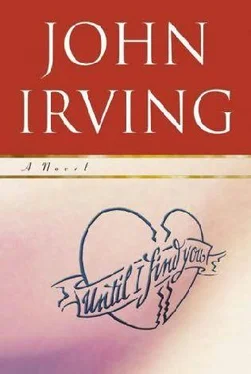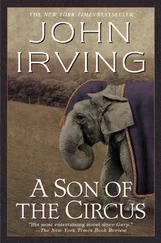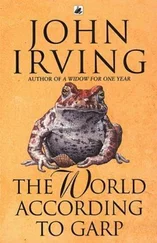It still felt cold enough to snow when he walked into Salve—an old-fashioned restaurant, the kind of place where you got fairly ordinary but home-cooked meals. If, as he’d once imagined, Helsinki was a tough town in which to be afflicted with self-doubts, Jack could see what the concierge had meant about a movie star showing up at Salve. Surely some of the locals were moviegoers; maybe they just hadn’t liked Jack Burns’s movies.
The waitresses were as he’d remembered them—hard-worked and fairly long-of-tooth. Jack was thinking about the tough waitress who’d been married to Sami Salo, the scratcher; she would have fit right in twenty-eight years later. She’d been tough enough to call Alice “dearie,” Jack recalled—although he wondered if the bad feelings between them had really been about his mom putting Sami out of business.
Jack remembered Mrs. Sami Salo, if that’s who she was, as a short, stout woman whose clothes were too tight. She’d squinted whenever she took a step, as though her feet hurt her; her fat arms had jiggled.
He was trying not to look at anybody too closely—certainly not to meet anyone’s eye—when the waitress came up to his table, which needed wiping. She used a wet dishcloth. Jack tried not to look too hard at her, either. She was as thin as Mrs. Sami Salo had been fat, or maybe only Mrs. Salo’s arms had been fat. He couldn’t remember. The thin waitress had hunched shoulders and a coarse complexion, but there was a kind of tired prettiness in her long face and catlike eyes; when she stood facing Jack at his table, she cocked one hip to the side as if her legs were tired, too.
“I hope you’re meeting someone,” she said. “You didn’t come here alone, did you?”
“Isn’t it all right to come here alone?” he asked.
“It’s not all right for you to come here alone,” she told him. “It might be safer for you to come here as a girl. ”
“I was hoping you could tell me where to get a tattoo,” Jack said. “This used to be the place to ask.”
“ I’m the one to ask,” the waitress said. “Seriously—if you aren’t meeting someone here, you better be sure you leave with someone.”
“What about the tattoo?” he asked.
“Movie stars shouldn’t get tattooed,” she told him. “It ruins you for the nude scenes.”
“There’s makeup for that,” Jack said.
“You probably shouldn’t get tattooed alone, either,” the waitress said. “Are you here making a movie?”
“Actually, I’m looking for a couple of lesbians. But I’ll start with where to get a tattoo,” he told her. She smiled for the first time; she was missing an eyetooth, which was probably why she was disinclined to smile.
“If you’re alone, I’ll go home with you,” the waitress said. “You can’t do much with a couple of lesbians.” She could tell he was thinking about it—another close-up opportunity. But Jack was suddenly tired, and he wanted to hold on to the memory of Ingrid Moe a little longer. “I’m not really old enough to be your mother,” the waitress added. “I just look it.”
“It’s not that. I’m just too tired,” he told her. “I’ve been traveling.”
“If you end up here, you’ve been traveling, all right,” she said.
“I’ll have the Arctic char, please,” Jack said.
“What are you drinking?”
“I don’t drink,” he told her.
“I’ll bring you a beer,” the waitress said. “You can just pretend you’re drinking it.”
She was wise to do that, because the locals kept toasting him—all through his dinner. The toasts were somehow sinister, even hostile—more challenging than friendly. Jack would raise his beer glass and pretend to swallow. They didn’t seem to notice that his glass stayed full, or they didn’t care. If there were Jack Burns fans in Finland, they had a way of masking their affection.
Jack didn’t go home with the waitress. She was nice about it. She made him wait at the table while she called him a taxi. Only when the cab was parked outside would she release him; she even walked him to the door, holding his arm the whole way.
“My name is Marianne. There are much more difficult names in Finland,” she said.
“I’ll bet there are, Marianne.”
She gave him a black-and-white business card; it was a little scary. The place was called The Duck’s Tattoo. There was an excellent drawing of Donald Duck, but he was smoking a blunt—a cigar filled with marijuana. His eyes were fried and he looked raving mad. Someone had wrapped a snake around the reefer-smoking duck, more in the manner of a straitjacket than a shawl.
There was a phone number written on the back of the business card. “That’s my number,” Marianne told Jack. “I’ve got a couple of tattoos I could show you, if you’re ever not too tired.”
“Thank you, Marianne.”
“The tattooist you want to see is Diego,” she said.
“Not a Finnish name, I guess.”
“Diego’s Italian, but he was born in Finland,” Marianne said. “He’s been in business here for fifteen years.”
The Duck’s Tattoo was on Kalevankatu—about a ten-minute walk from the Torni, the concierge said the next morning. The concierge also sent Jack to a gym near the hotel, Kuntokeskus Motivus. (“Call it Motivus for short,” the concierge had recommended.) It was clean, with lots of free weights, but Jack was distracted during his workout by a pregnancy-aerobics class. The bouncing women were doing dangerous-looking things.
On his way to The Duck’s Tattoo, Jack passed a porn shop. One of the magazines in the window was a German one called Schwangere Girls. All the women were pregnant; more bouncing women doing dangerous-looking things. Pregnancy seemed to have made itself the unwanted theme of Jack’s day.
Helsinki struck him as a warren of construction sites. He found himself in a part of the city that had been built by the Russians a hundred years before. The Duck’s Tattoo was opposite the former Russian Army Hospital. It had been a sailors’ neighborhood, with lots of sailors’ pubs and restaurants—like Salve used to be—but the neighborhood was growing trendier by the day, Diego later told Jack.
Diego was a small man with friendly eyes and a goatee; his forearms were completely covered with tattoos. One was a rather formal portrait of a woman, almost like a photograph. Another was an entirely less formal-looking woman, who was naked; in fact, she was naked with a duck. Diego had other tattoos, but the naked woman with the duck was the one Jack would remember best.
He liked Diego, who’d never met Daughter Alice but had heard of her. Diego had three children and was not a regular participant at the tattoo conventions. He’d studied with Verber in Berlin; he’d worked in Cape Town, South Africa. He was planning a trip to Thailand to get a handmade tattoo by a monk in a monastery. “A chest tattoo,” he called it. He was inclined to “big works,” Diego said—both getting them and doing them. He’d recently copied a whole movie poster onto someone’s back.
Diego had two apprentices working with him. One of them was a muscleman in camouflage pants and a black Jack Daniel’s T-shirt. The other was a blond woman named Taru. Evidently Taru did the piercing; she had a silver stud in her tongue. There was another guy in The Duck’s Tattoo—a friend of Diego’s named Nipa, who told Jack a fairly involved story about accidentally dropping a paperback novel in a toilet. It was his favorite novel, Nipa said, and he was trying to figure out a way to dry it.
Jack talked to Diego about the relationship between sailors and tattooing. Diego had his first boat when he was just fourteen. The flash in The Duck’s Tattoo was impressive: Indian chiefs, dragons, skulls, birds, Harley engines, and many cartoon characters, like The Joker—and ducks, of course, lots of edgy ducks.
Читать дальше












